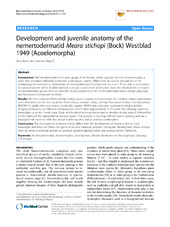Development and juvenile anatomy of the nemertodermatid Meara stichopi (Bock) Westblad 1949 (Acoelomorpha)
Journal article, Peer reviewed
Published version

Date
2014-07-07Metadata
Show full item recordCollections
Original version
https://doi.org/10.1186/1742-9994-11-50Abstract
Introduction: Nemertodermatida is the sister group of the Acoela, which together form the Acoelomorpha, a taxon that comprises bilaterally symmetric, small aquatic worms. While there are several descriptions of the embryology of acoel species, descriptions of nemertodermatid development are scarce. To be able to reconstruct the ground pattern of the Acoelomorpha it is crucial to gain more information about the development of several nemertodermatid species. Here we describe the development of the nemertodermatid Meara stichopi using light and fluorescent microscopic methods. Results: We have collected Meara stichopi during several seasons and reconstruct the complex annual reproductive cycle dependent on the sea cucumber Parastichopus tremulus. Using common fluorescent markers for musculature (BODIPY FL-phallacidin) and neurons (antibodies against FMRFamide, serotonin, tyrosinated-tubulin) and live imaging techniques, we followed embryogenesis which takes approximately 9–10 weeks. The cleavage pattern is stereotypic up to the 16-cell stage. Ring- and longitudinal musculature start to develop during week 6, followed by the formation of the basiepidermal nervous system. The juvenile is hatching without mouth opening and has a basiepidermal nerve net with two dorsal neurite bundles and an anterior condensation. Conclusions: The development of Meara stichopi differs from the development of Acoela in that it is less stereotypic and does not follow the typical acoel duet cleavage program. During late development Meara stichopi does not show a temporal anterior to posterior gradient during muscle and nervous system formation.
Publisher
BioMed CentralJournal
Frontiers in ZoologyCopyright
Copyright 2014 Børve and Hejnol; licensee BioMed Central Ltd.Aina Børve et al.; licensee BioMed Central Ltd.
